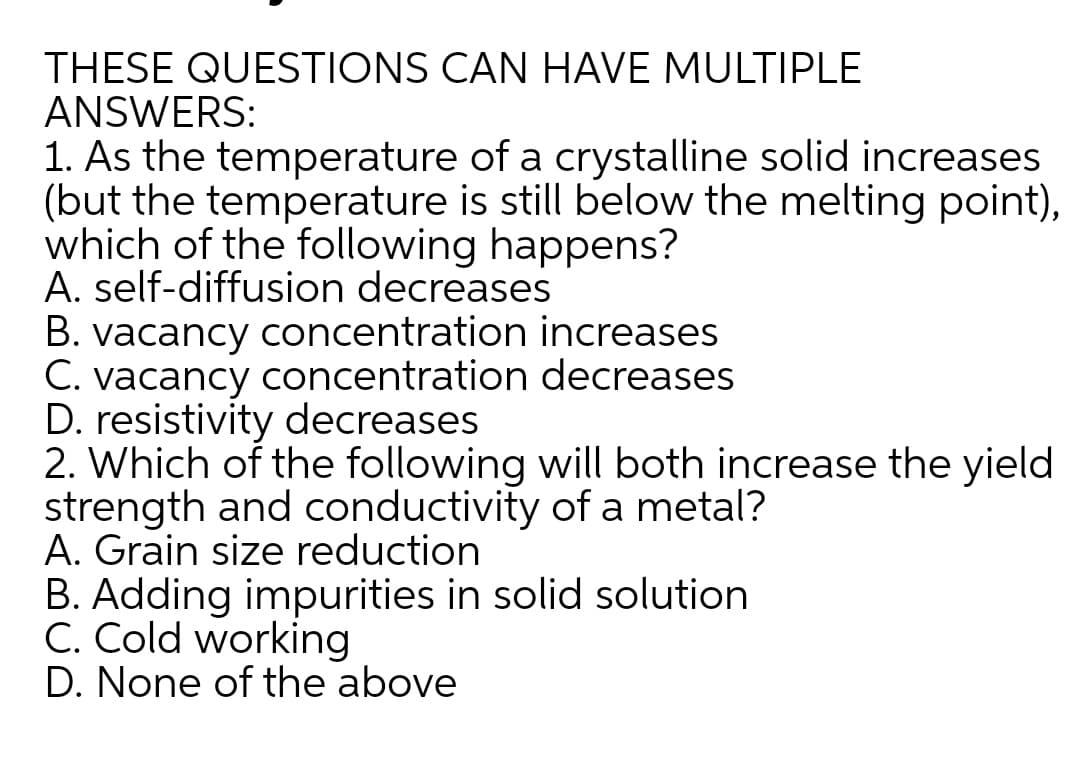THESE QUESTIONS CAN HAVE MULTIPLE ANSWERS: 1. As the temperature of a crystalline solid increases (but the temperature is still below the melting point), which of the following happens? A. self-diffusion decreases B. vacancy concentration increases C. vacancy concentration decreases D. resistivity decreases 2. Which of the following will both increase the yield strength and conductivity of a metal? A. Grain size reduction B. Adding impurities in solid solution C. Cold working D. None of the above
THESE QUESTIONS CAN HAVE MULTIPLE ANSWERS: 1. As the temperature of a crystalline solid increases (but the temperature is still below the melting point), which of the following happens? A. self-diffusion decreases B. vacancy concentration increases C. vacancy concentration decreases D. resistivity decreases 2. Which of the following will both increase the yield strength and conductivity of a metal? A. Grain size reduction B. Adding impurities in solid solution C. Cold working D. None of the above
Chemistry & Chemical Reactivity
10th Edition
ISBN:9781337399074
Author:John C. Kotz, Paul M. Treichel, John Townsend, David Treichel
Publisher:John C. Kotz, Paul M. Treichel, John Townsend, David Treichel
Chapter12: The Solid State
Section: Chapter Questions
Problem 30PS: The structure of graphite is given in Figure 12.19. (a) What type of intermolecular forces exist...
Related questions
Question
100%

Transcribed Image Text:THESE QUESTIONS CAN HAVE MULTIPLE
ANSWERS:
1. As the temperature of a crystalline solid increases
(but the temperature is still below the melting point),
which of the following happens?
A. self-diffusion decreases
B. vacancy concentration increases
C. vacancy concentration decreases
D. resistivity decreases
2. Which of the following will both increase the yield
strength and conductivity of a metal?
A. Grain size reduction
B. Adding impurities in solid solution
C. Cold working
D. None of the above
Expert Solution
This question has been solved!
Explore an expertly crafted, step-by-step solution for a thorough understanding of key concepts.
This is a popular solution!
Trending now
This is a popular solution!
Step by step
Solved in 2 steps

Knowledge Booster
Learn more about
Need a deep-dive on the concept behind this application? Look no further. Learn more about this topic, chemistry and related others by exploring similar questions and additional content below.Recommended textbooks for you

Chemistry & Chemical Reactivity
Chemistry
ISBN:
9781337399074
Author:
John C. Kotz, Paul M. Treichel, John Townsend, David Treichel
Publisher:
Cengage Learning

Chemistry & Chemical Reactivity
Chemistry
ISBN:
9781133949640
Author:
John C. Kotz, Paul M. Treichel, John Townsend, David Treichel
Publisher:
Cengage Learning

Principles of Modern Chemistry
Chemistry
ISBN:
9781305079113
Author:
David W. Oxtoby, H. Pat Gillis, Laurie J. Butler
Publisher:
Cengage Learning

Chemistry & Chemical Reactivity
Chemistry
ISBN:
9781337399074
Author:
John C. Kotz, Paul M. Treichel, John Townsend, David Treichel
Publisher:
Cengage Learning

Chemistry & Chemical Reactivity
Chemistry
ISBN:
9781133949640
Author:
John C. Kotz, Paul M. Treichel, John Townsend, David Treichel
Publisher:
Cengage Learning

Principles of Modern Chemistry
Chemistry
ISBN:
9781305079113
Author:
David W. Oxtoby, H. Pat Gillis, Laurie J. Butler
Publisher:
Cengage Learning

Physical Chemistry
Chemistry
ISBN:
9781133958437
Author:
Ball, David W. (david Warren), BAER, Tomas
Publisher:
Wadsworth Cengage Learning,

Chemistry by OpenStax (2015-05-04)
Chemistry
ISBN:
9781938168390
Author:
Klaus Theopold, Richard H Langley, Paul Flowers, William R. Robinson, Mark Blaser
Publisher:
OpenStax

Chemistry
Chemistry
ISBN:
9781305957404
Author:
Steven S. Zumdahl, Susan A. Zumdahl, Donald J. DeCoste
Publisher:
Cengage Learning